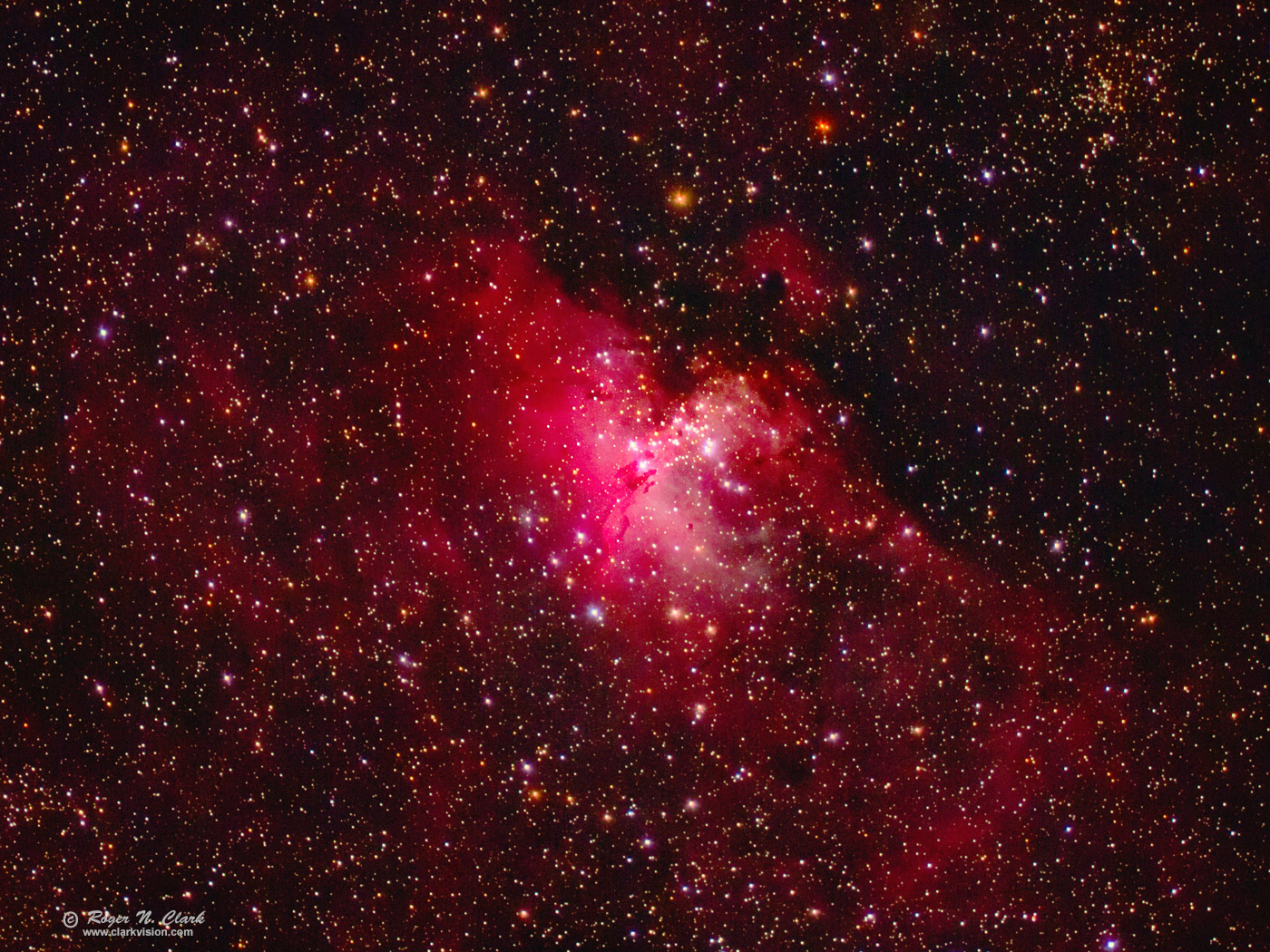| Home | Galleries | Articles | Reviews | Best Gear | New | About | Contact | Gallery Index | Previous |
Next |

| Home | Galleries | Articles | Reviews | Best Gear | New | About | Contact | Gallery Index | Previous |
Next |

The emission nebula M16 is a beautiful nebula in the constellation Serpens, and is a beautiful view in amateur telescopes from dark sites. M16 is a region of active star formation about 7000 light years away. Many of the stars seen in and near M16 are hot young O and B-type stars, while most of the stars seen in the region are old cooler yellow to red stars, stars cooler than our sun. The dark patches in the nebula, the "Pillars of Creation" can be seen in telescopes as small as 8 to 10 inches aperture under very dark skies. Below is a link to a larger version of the image.
This is a natural color image but the saturation has been enhanced. The high dynamic range of astrophotos must be stretched to bring out the range of details the camera recorded. But the typical image stretch process loses color for brighter subjects (e.g. stars and the brighter parts of deep sky objects become whiter as they are made brighter). This image uses a new algorithm, rnc-color-stretch that does not lose color during the stretch. How do we know the colors are reasonable? The star colors can be checked against stellar photometry. Red stars have B-V > 2, orange stars have B-V of 1 to about 2. The blue-white stars have B-V in the range of 0 to -0.5. The colors closely follow the color sequence in Table 1 at Color of Stars. Solar-type stars have a B-V of 0.63 and appear close to white (daylight white balance).
Technical. Canon 7D Mark II 20-megapixel digital camera and 300 mm f/2.8 L IS II at f/2.8 plus a 1.4x teleconverter giving 420 mm at f/4, ISO 3200. Forty six 30-second exposures at ISO 3200 were added (23 minutes total exposure). I would normally use ISO 1600 and 60-second exposures, but seeing was bad, the object was low in the sky, and it was breezy, so I shortened the exposure in case of camera shake and to try and catch moments of stable atmosphere. Full resolution image is at 2.0 arc-seconds per pixel, and the image here is 3.3 arc-seconds per pixel. No dark frame subtraction, no flat fields. Tracking with an astrotrac and no guiding.
Post processing: Converted in rawtherapee with color preserving methodology, aligned with deep sky stacker, then stretched with rnc-color-stretch. Also see Astrophotography Image Processing Basic Work Flow. I applied Richardson-Lucy deconvolution to improve resolution on the stacked and stretched result.
The Exposure Factors, CEF, CEFA are measures of the relative amounts of light received from a subject. It can be used to fairly compare wildly different lens/telescope apertures and exposure times. For this image:
Larger image, 1481 x 2121 pixels, 3.3 arc-seconds/pixel, 1.3 megabytes.
Modern DSLRs like the 7D Mark II include On-Sensor Dark Current Suppression Technology and low fixed pattern noise at ISOs around 1600 and higher, making no need for dark frame subtraction. Modern raw converters correct for light fall-off (flat field correction on linear sensor data) and also correct for hot/dead/stuck pixels. This makes processing low light images easy: simply align and average. See my series on Astrophotography Image Processing for more details.
To learn how to obtain stunning images like this, please visit my Extensive Articles on Photography .
See my review of the Canon 7D Mark II and why it is so good for astrophotography: Canon 7D Mark II sensor analysis.
Keywords to this image = astrophoto-1 nebula Messier low-light digital_astro canon_7d2
Image ID: m16-av46-rnclark-420mm-c08-12-2018.f-c3-0.6x.jpg
| Home | Galleries | Articles | Reviews | Best Gear | Science | New | About | Contact |
Last updated November 03, 2025